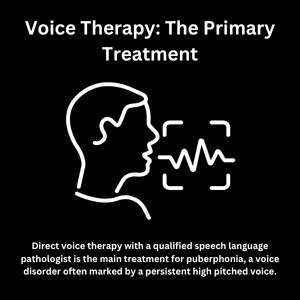
When a teenage boy’s voice remains unusually high-pitched long after puberty, it can shake his confidence and affect his daily life. This condition, called puberphonia or mutational falsetto, affects young men whose voices never dropped to the expected lower range. The good news? This voice disorder responds well to treatment, and most teens can achieve a normal, lower pitched voice through targeted speech and language therapy.
Treating puberphonia begins with a perceptual assessment to evaluate the pitch, quality, and range the patient can achieve, including how unusually he could produce higher tones. Puberphonia patients often present with functional issues related to pitch control and speech issues caused by improper tension in the vocal cords.
A customized voice therapy program may include digital manipulation, proper glottal attack techniques, and exercises targeting low pitch control. Therapy for puberphonia patients based on their individual needs has proven to be a promising modality. The treatment scale consists of progressive voice exercises to help develop a more natural, masculine tone and improved vocal function.
What Is Puberphonia?
Puberphonia occurs when someone maintains a very high pitched voice even after their body has gone through puberty. While most teenage boys experience a dramatic change during adolescence, some continue speaking in a childlike, female voice that doesn’t match their age or physical development.
This functional falsetto affects how others perceive the young person. People often mistake him for a woman on the phone or assume he’s much younger than his actual age. The quality tends to be breathy and weak, making it hard for him to project his voice in noisy settings or speak loudly when needed.
The condition is physically and mentally uncomfortable for many teens. The higher pitch can fatigue easily during long conversations, sometimes causing throat pain or tension. Beyond the physical symptoms, the social impact can be significant. Many teens with puberphonia feel embarrassed about their voice and may avoid speaking in class or social situations.
Speech pathologists classify puberphonia as a disorder where the pitch range doesn’t match what’s expected after puberty. The vocal cords are typically normal, but the person has developed a pattern of speaking in falsetto register instead of using their natural chest voice.
Understanding the Normal Voice Change

During typical male puberty, testosterone causes the larynx to grow larger and the vocal folds to lengthen and thicken. This physical change drops the voice by about an octave, from around 250 Hz to roughly 100-150 Hz. The thyroid cartilage, commonly called the Adam’s apple, becomes more prominent as the voice box or larynx matures.
In mutational falsetto or functional falsetto cases like puberphonia, this transition doesn’t happen as expected. The teen’s vocal folds are physically developed, but the patient’s voice remains in a high pitch, showing signs such as a less prominent Adam’s apple during speech. Interestingly, individuals present with the ability to produce lower-pitched sounds during coughing or throat clearing, which helps speech pathologists confirm that the vocal folds are functional.
Treating puberphonia involves speech therapy and language therapy designed to expand the pitch scale and build vocal confidence. Speech pathologists create customized treatment plans to address the habits formed during puberty. Therapy often restores a healthy pitch and reduces issues like voice fatigued easily, ultimately giving appropriate credit to the progress made through consistent intervention.
What Causes Puberphonia?
Several factors can contribute to this disorder, though the exact cause varies from person to person. Psychological factors often play a role. Some teens subconsciously resist the voice change because it represents growing up. The transition to adulthood can feel overwhelming, and maintaining a childlike voice becomes a way to avoid this change.
Emotional stress during puberty can also influence development. If a boy experienced embarrassing voice cracks or felt self-conscious during the voice change period, he might have learned to use falsetto as a more controlled option. Over time, this becomes a habit that’s hard to break without help.
Sometimes no deep psychological issues exist. The teen simply got into the pattern of speaking at a higher pitch and never learned to use their new, lower register effectively. We humans tend to stick with what feels familiar, even when what we’re used to is inappropriate or limiting for us.
From a physiological perspective, most cases show normal vocal anatomy. However, a thorough evaluation rules out any organic causes like vocal fold problems, hormonal imbalances, or structural differences in the larynx that might contribute to the high pitched voice.
Getting Professional Help

When parents notice their teenager’s voice hasn’t changed appropriately, the first step is seeking professional evaluation. This typically involves both an ENT surgeon and a speech language pathologist who specializes in voice disorders.
The detailed ENT evaluation includes examining the vocal folds and larynx, often using a small camera scope. This visual assessment confirms that the voice box structure is normal and rules out any medical conditions that might cause voice problems. In puberphonia cases, the exam usually shows healthy vocal anatomy.
The speech therapist conducts a comprehensive voice assessment to document exactly how the voice sounds and functions. This includes measuring the speaking pitch, analyzing voice quality, and testing the vocal range. Many clinics use tools like the Multi Dimensional Voice Program to get precise measurements of voice characteristics.
During evaluation, the clinician often tries simple techniques to see if the patient can produce a lower voice, even briefly. Having the teen cough or throat clear often reveals their natural, deeper voice hiding underneath the falsetto habit. This tells everyone that voice therapy can likely help.
Voice Therapy: The Primary Treatment

Direct voice therapy with a qualified speech language pathologist is the main treatment for puberphonia, a voice disorder often marked by a persistent high pitched voice. This behavioral approach teaches the teen how to adjust their voice production, essentially retraining them to speak at the appropriate lower pitch.
The results are often remarkable and surprisingly quick. Most puberphonic patients see significant improvement in just 2-3 voice therapy sessions. Some individuals achieve a normal male voice after a single extended session, though follow-up speech therapy and voice therapy visits help ensure the change sticks. When combined with speech and language therapy, this treatment addresses both the physical and functional aspects of the voice disorder, ensuring long-term success.
Adolescents with this voice disorder often feel a boost in self-confidence and social comfort as their pitch begins to match their physical development. Early intervention with effective voice therapy improves outcomes and helps teens move past the difficulties caused by a high pitched voice, supporting healthier communication habits moving forward.
Key Therapy Techniques
The speech therapist uses various approaches to help shift the patient’s pitch from the high falsetto register down to normal chest voice production. Education plays an important role – many teens don’t understand how voice works or have misconceptions about their “deep voice” sounding bad.
Visual feedback tools help tremendously. Computer programs can display the teen’s pitch in real-time, letting him see his pitch move from the high range down into the target zone for his age. This makes voice practice more engaging and gives clear goals to work toward.
Relaxation techniques address the muscle tension that often accompanies puberphonia. The yawn-sigh method works well – having the patient yawn naturally drops the larynx and opens the throat, then sighing out a sound often produces a lower tone. Gentle massage around the voice box can also help reposition the larynx and reduce tension.
Getting that first lower sound is a crucial breakthrough moment. Therapists use vegetative sounds like coughing, throat clearing, or laughing as gateways to the natural pitch. After a cough, the teen immediately tries to say “hello” in that same deeper tone. The glottal attack technique – starting a vowel sound with firm pressure – can also kick-start the vocal cords into chest register.
Once the lower voice emerges, practice begins with sustaining vowel sounds at the new pitch, then progressing to words, sentences, and conversational level speech. The therapist provides feedback to keep the pitch quality strong without strain while maintaining an appropriately low but natural pitch.
Making It Stick
A critical part of voice therapy involves helping the teenager accept their new voice and use it consistently. Many initially feel the deeper pitch sounds strange because they’re so used to the higher pitch. With encouragement and positive feedback, most come to prefer their mature-sounding pitch and grow more confident using a healthier pitch range in daily conversations.
Practice starts with family and close friends, gradually expanding to school and public settings as confidence grows. Building vocal stamina is important too. The teen practices speaking longer in the new pitch each day to strengthen the vocal muscles. This gradual approach also helps reinforce proper technique and prevents strain, especially for those dealing with a voice disorder like puberphonia.
Follow-up sessions a few weeks later check that the patient hasn’t slipped back into old habits. Ongoing voice therapy support helps maintain progress and ensures the teen continues using their full pitch range with ease. With proper treatment, the voice change typically becomes permanent, and cases of puberphonia rarely return. Successful outcomes are not only measured by pitch correction but also by improved communication and self-esteem.
Addressing Underlying Issues
Addressing Emotional Factors
Beyond the direct pitch work, comprehensive treatment often includes indirect therapy to address psychological factors. If a teen’s high pitch connects to anxiety about growing up or other emotional concerns, counseling support helps tremendously. Integrating speech and language therapy with emotional support can improve long-term outcomes.
Supportive Environment in Therapy
The speech and language therapy setting provides a supportive environment where the teen can gradually become comfortable with their new sound. The speech language pathologist encourages confidence and offers consistent feedback. Sometimes working with a psychologist helps address deeper issues like fear of change or social anxiety that might be contributing to the voice problem.
Family and Peer Encouragement
Family support plays a key role too. Parents can encourage their child’s efforts without drawing negative attention to any temporary awkwardness during the pitch transition period. At home, practicing newly learned voice techniques as part of speech and language therapy reinforces progress. Friends thought nothing of the high voice often quickly adapt to and prefer the new, mature-sounding voice, which boosts the teen’s confidence and social comfort.
When Additional Treatment Is Needed
Behavioral Therapy First

Fortunately, most cases of puberphonia respond well to behavioral therapy techniques alone. Speech and language therapy remains the primary treatment, and voice therapy should always be the first choice given its high success rate and non-invasive nature. These sessions help retrain voice production and guide the teen toward using a more natural, lower pitch consistently.
When Therapy Alone Isn’t Enough
In rare situations where standard therapy doesn’t achieve the desired results, other treatment methods might be considered. For some individuals, muscle tension may interfere with normal voice production. Medical interventions like Botox injections have been tried in certain resistant cases to relax overactive muscles that might be keeping the larynx positioned too high, limiting the range of the patient’s pitch.
Surgical Considerations
Surgical options exist as a last resort when all forms of therapy have failed over an extended period. These procedures typically focus on altering the position or tension of the thyroid cartilage, which can change how the vocal folds vibrate and permanently deeper pitch. However, surgery is extremely uncommon because nearly all patients eventually respond well to speech and language therapy when techniques are properly applied by experienced clinicians.
Emerging Techniques
Some newer techniques like pharyngeal resonance manipulation are emerging as promising alternatives. This method attempts to reshape the resonance characteristics of the patient’s voice, supporting a more masculine tone. While results so far are encouraging, more research is needed to confirm long-term outcomes and how these techniques compare to standard speech and language therapy in treating persistent cases.
What to Expect: Outcomes and Recovery
The intervention outcomes for treating puberphonia are excellent. With appropriate treatment, teenagers can expect to achieve a normal-sounding, age-appropriate pitch and experience significant improvements in their daily lives.
Studies consistently show high success rates for those who complete voice therapy. Patients typically see marked improvements in their fundamental frequency measurements and overall voice quality. More importantly, teens report feeling much more confident and comfortable.
The psychological benefits extend far beyond just change of pitch. Many teens become more outgoing and willing to participate in conversations once they no longer feel self-conscious about how they sound. Parents often notice their son seems happier and more confident in social situations.
The voice change tends to be stable long-term. Follow-up studies show that patients maintain their lower pitch years after treatment. Occasionally someone might need a brief refresher session during times of stress, but this is uncommon when therapy is completed properly.
Moving Forward with Confidence
Puberphonia treatment truly focuses on restoring confidence in teenagers. A voice that doesn’t match someone’s identity can seriously impact self-esteem during these crucial developmental years. Through effective speech therapy, teens reclaim not just a mature-sounding voice, but also the confidence to use it freely.
They no longer avoid speaking up in class or shy away from phone conversations. This opens doors for fuller participation in social life and allows their personality to shine without the shadow of an inappropriate voice holding them back.
The combination of skilled voice therapy, psychological support when needed, and family encouragement creates the foundation for successful treatment. If your teenager struggles with a persistently high voice after puberty, don’t wait to seek help from a qualified speech therapist.
Voice disorders like puberphonia may seem unusual, but they respond remarkably well to proper treatment. With targeted therapy techniques and support, teens can overcome this challenge and speak with a clear, confident voice that matches who they really are. The journey from a limiting voice problem to restored confidence often takes just a few therapy sessions – a small investment for life-changing results.
Most teenagers who complete puberphonia treatment report feeling like themselves for the first time in years. They can finally communicate without worrying about how others perceive their voice, freeing them to focus on what they want to say rather than how they sound saying it. This transformation from physically and psychologically uncomfortable voice patterns to natural, confident communication truly restores not just their voice, but their sense of self.
